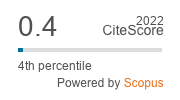Influence of spinosad on the reproductive potential of Tribolium castaneum (Herbst), (Coleoptera: Tenebrionidae) infesting wheat
DOI:
https://doi.org/10.33307/entomon.v44i4.476Abstract
Spinodad of different concentrations were screened against Tribolium castaneum (Herbst) reared on four local wheat varieties to observed the effects on reproductive potentials for two successive generations.The lowest number of eggs laid was 119 (23.80±0.97) observed in Shatabdi- 21 (S-21) in 45 d in F1 and 15 (3.00±0.71) in 15 d in F2 generation when treated at 0.12ìl/g of spinosad. Spinosad at all concentration totally inhibited egg laying oroviposition rate on day 45 in all wheat varieties except P-24 variety in F1 generation.The lowest fertility was found in Shatabdi-21 variety as 12.61percent in F1 and 6.67 percent in F2 generation at 0.12ìl/g.The latent effect of spinosad on number of eggs, larva, pupa and adult obtained in Shatabdi-21 as 2.00±0.32,0.80±0.37, 0.40±0.40 and 0.20±0.20 at 0.12ìl/g of spinosad in F2 generation.There was no significant difference between the number of males and females in F2 generation wheat varieties. Spinosad ultimately reduced the fecundity, fertility and decreased the egg to adult survivability in four wheat varieties compared to control and F1 and F2 generations. Results of the research revealed that comparatively higher concentrations of spinosad that used in this study would potentially control development and reproductive potentiality of T. castaneum in wheat varieties.


